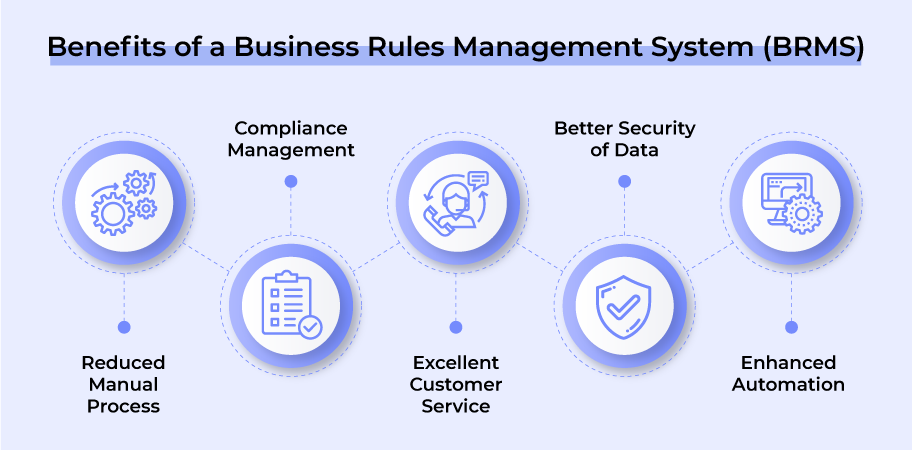
A business rules management system (BRMS) enables organizations to develop, manage, and implement scalable business rules.
With business rules management, organizations can achieve targets at scale without having to liaise with their relevant authorities constantly. By automating policy execution, business rules management makes it easier to apply policies when needed. According to a study, the Business Rules Management System market is supposed to grow at a CAGR of 11.8% from 2022 to 2025.
This article explores what business rules management and a BRMS (business rules management system) are, how they can help you get better results faster, and how they help you sync with your processes even further.
What are Business Rules?
The business rules of an organization define and/or constrain its actions. An organization’s business rules specify its objectives and provide guidelines for how processes are to be carried out. Business rules are often undocumented and informal in many organizations. Employees in these organizations understand their job functions and do it according to their ingrained understanding.
Consider the case of a customer who wants to return a product. Here are some examples of business rules that determine how returns will be processed:
Scenario 1: Product Return Eligibility Based on Condition
In this scenario, the business rules are designed to handle returns based on the condition of the product being returned:
- If the product is unopened and in its original packaging:
Offer a full refund to the customer. - If the product has been opened or used but is within 30 days of the purchase date:
Provide an option for a store credit or exchange. - If the product is damaged or defective, regardless of the purchase date:
Offer a full refund or exchange, and cover return shipping costs.
Scenario 2: Return Handling for Membership-based Customers
In this scenario, the business rules are customized for customers who are members of a loyalty program:
- If the customer is a loyal member and the product was purchased within the last 60 days:
Provide a full refund, including any applicable discounts or rewards. - If the customer is a member but the product was purchased more than 60 days ago:
Offer store credit equal to the original purchase price. - If the customer is not a member:
Apply the standard return policy based on the purchase date and condition of the product.
Scenario 3: Seasonal or Special Event Returns
In this scenario, the business rules are adjusted for returns during special events or holiday seasons:
- During the holiday season (e.g., November 15th to December 31st):
Extend the return window to 45 days for all products. - For products bought during special promotional events (e.g., Black Friday sales):
Allow returns within 15 days of purchase, but only offer store credit. - For regular non-seasonal purchases:
Follow the standard return policy, as mentioned earlier.
Undocumented business rules create inefficiencies and inconsistencies. An organization’s business processes are formally defined through business rules management. Business rules management ensures that all members of an organization are aware of business objectives and processes. In this way, organizations can scale their operations while providing employees with high autonomy.
Also Read: All you need to know about Business Process Maturity Model
What is a Business Rules Management System (BRMS)?
BRMSs are software solutions that define, deploy, execute, monitor, and manage business rules and decision logic. An organization’s business processes are automated with a BRMS. Business rules can be linked with technological solutions that perform the required functions through a BRMS, which can distinguish between relationships between business rules.

Components of a BRMS
There are three main components of a BRMS:
A development environment
Business rules must be expressed in a conditional programming language to be readable by automated applications. Logic qualifiers used in coding projects include “IF-THEN”, “IF-ELSE”, “ONLY IF”, “WHEN”, etc.
Business rules can be written in a conditional language using a BRMS’s low-code or no-code development environment. Consider again the customer refund request outlined above. Here is an example of how that rule might be expressed conditionally:
If the customer ordered a product less than 30 days ago, the product should be refunded. Alternatively, you can offer store credit.
Decision tables can also be used to express business rules in which more than one condition influences the appropriate action. Business users might prepare a decision table like this if item pricing also affects the return procedure:
| Item Price | Purchased | Purchased >30 Days Ago |
|---|---|---|
| Issue Full Refund | Issue Full Refund | |
| >=$100 | Issue Full Refund | Other Store Credit |
A Rules Repository
The BRMS’s central repository stores rule once they’ve been defined. Various applications can access, review, and edit rules in this system.
Business Rules Engine
In an enterprise ecosystem, the rules engine allows other applications to access the rules repository and execute those rules at runtime. A request is sent to the BRMS with all the data that the rules engine needs to decide. Once the request has been checked against the relevant rules, the rules engine returns a decision. As a result of this decision, the application takes some specific action.
Business rule pseudo-code example:
Platinum club members
Apply a 20% discount
Or Else
Get 5% off
Also Read: Business Process Management – The What, Why, and How
Practical Application of Business Rules Management System
Business decision-making can be automated with BRMSs across a wide range of industries and departments. The following are a few examples of BRMS use cases:
- To allocate organ transplants, the UK National Health Service Blood and Transplant use a BRMS. A BRMS triggers certain workflows when an organ becomes available to find the next recipient on the transplant list and make the match between the organ and the patient.
- A BRMS was used by the PNC Financial Services Group to automate the loan application process, creating rules to determine whether an application is accepted or rejected. All loans were reviewed before, but now only 10-20% are reviewed, leading to faster, more reliable, and more compliant loan decisions.
- Brownells Inc. uses a Business Rules Management System to automate compliance as an e-commerce organization in a highly regulated industry. By using a system of rules based on a customer’s location, the company ensures customers can only purchase products available in their area.
- A BRMS helped Panalpina World Transport automate shipping updates to customers. Panalpina’s database automatically uploads customer information, and business rules determine when to send custom messages.
Watch Webinar: Learning how to use Business Rules and Validations in Quixy
Benefits of a Business Rules Management System (BRMS)

An organization can benefit from a business rules management system in several ways. Among the key advantages are the following:
- Reduced manual processing of recurring decisions through automated decision-making scalability of decision rules across multiple applications.
- Maintain compliance with applicable policies and regulations. By encapsulating policies and regulations within business rules, BRMSs ensure automatic compliance and provide an audit trail.
- A superior customer experience and improved customer service. By implementing BRMS, organizations can guide customer service agents through best practices and enhance self-service capabilities.
- Enhancements to security. Prevents unauthorized individuals from altering, losing, or accessing business rules.
- Enhancing decision logic by analyzing and automating. Business Rules Management Systems help organizations identify areas for improvement in their decision logic. Business vocabulary syntax and graphical rule representations can also be used to express decision logic precisely.
Also Read: Process vs Procedure: Differences and Examples
The use of BRMS in conjunction with BPM
It is important to understand the differences between a BRMS and a business process management (BPM) system before understanding how they can be used together. BRMSs define, execute, and manage business rules. However, BPM systems help organizations increase efficiency and productivity by optimizing their business processes.
Tasks are performed according to clearly defined business rules. Business rules form the foundation of efficient processes when they are implemented and managed by a BRMS. Utilizing BPM, organizations can improve productivity, reduce costs, and improve compliance by optimizing processes.

Who needs a Business Rules Management System?
The use of business rules management systems is widespread across industries. The following types of organizations can benefit from a BRMS:
- A company governed by business rules and/or internal policies affecting stakeholders. With a BRMS, all rules, regulations, and relevant considerations that an organization is subject to are taken into account during the decision process.
- Making more informed decisions while improving efficiency. Making business decisions can be time-consuming for many organizations, particularly those that rely on antiquated decision-making processes. Through a BRMS, organizations can improve the speed and accuracy of critical decisions through technological solutions like automation.
- Legal and regulatory actions can be reduced for organizations that want to increase compliance. A BRMS can simplify compliance in industries with significant regulatory obligations, such as banking.
- A need for flexibility in adapting to changing market conditions and/or pivoting to new business opportunities. Adapting quickly and pivoting to take advantage of new opportunities is more critical than ever.
Conclusion
Business Rules Management Systems aims to make it easier for non-technical users to define, maintain, and execute business rules.
Decisions can be made based on business rules or workflows can be guided by them. The process of documenting business rules can be complicated and costly due to the many competing standards used today. Business rule definition, business rule maintenance, and business rule analytics offer UI and UX practitioners opportunities.
As businesses continue to operate in a decentralized and globalized manner, and as business operations become increasingly complex due to the ever-increasing capabilities of technology, BRMS, along with UX/UI professionals who serve the market, will continue to provide decision-makers with an increasing and very broad range of value-added services.
Frequently Asked Questions (FAQs)
Q. What is a Business Rule Management System (BRMS) used for?
A Business Rule Management System (BRMS) is a software tool that enables organizations to manage business rules effectively. Business rules are specific statements that define the policies, regulations, procedures, and constraints within an organization. BRMS provides a centralized approach to capture, store, organize, and deploy these rules across different systems and applications. It allows business users to easily define, update, and manage rules without the need for extensive programming knowledge.
Q. Can you provide an Example of a Business Rule Management System?
One example of Business Rules can be “If a customer purchases five or more products, they are eligible for a 10% discount on their total order.” These rules can then be used to create personalized customer experience.
Q. What expertise is needed to use and maintain a BRMS?
Using and maintaining a Business Rules Management System (BRMS) typically requires a moderate level of technical expertise and training. Users should have a foundational understanding of the system’s functionalities and how to configure, update, and manage rules within the platform.
Q. What is BRMS?
A Business Rules Management System (BRMS) is a software solution that allows organizations to define, manage, and automate business rules and decision logic within their operations. It enables businesses to create, store, modify, and execute rules without the need for extensive coding, offering a more flexible and adaptable approach to managing complex business rules and policies. BRMS systems are used to streamline processes, improve decision-making, and enhance agility in responding to changes in business requirements or regulations.
Q. Can a BRMS assist in monitoring and analyzing rule performance or effectiveness?
Yes, a BRMS can aid in monitoring and analyzing the performance and effectiveness of rules. It provides tools and functionalities to track the execution of rules, gather data on their outcomes, and analyze their impact on decision-making processes. This analysis helps in assessing rule efficiency, identifying areas for improvement, and making informed adjustments to optimize the overall effectiveness of business rules within the system.
Subscribe
Login
Please login to comment
0 Comments
Oldest
















